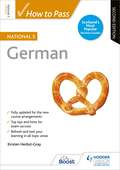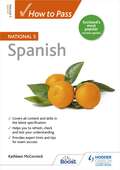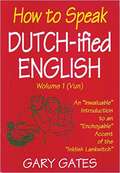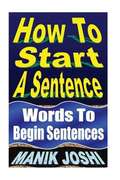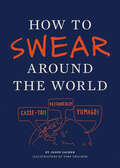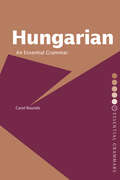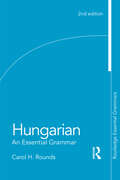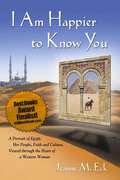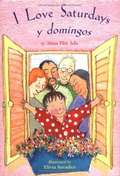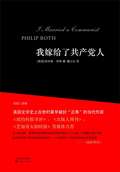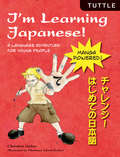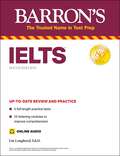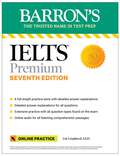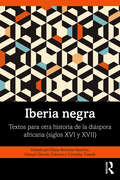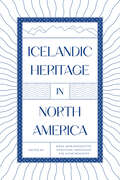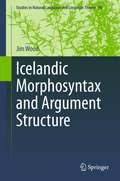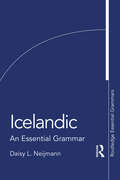- Table View
- List View
How to Pass National 5 German: Second Edition Ebook
by Kirsten Herbst-GrayGet your best grade with How to Pass National 5 German.Fully updated to account for the removal of Unit Assessments and the changes to the National 5 exam, this book contains all the advice and support you need to revise successfully. It combines an overview of the course syllabus with advice from a top expert on how to improve exam performance, so you have the best chance of success.- Refresh your knowledge with complete course notes- Prepare for the exam with top tips and hints on revision technique- Get your best grade with advice on how to gain those vital extra marks
How to Pass National 5 Spanish
by Kathleen McCormickTrust Scotland's most popular revision guides to deliver the results you want. The How to Pass series is chosen by students, parents and teachers again and again.This is the only study guide that is structured around the skills of reading, writing, listening and talking, to align closely with the assessments.> Practise, practise, practise. Develop the four key skills as you answer questions across the specified contexts of society, learning, employability and culture.> Read, listen, succeed. All-new text extracts and audio files give you plenty of opportunities to build your understanding of the Spanish language so you can aim for a better grade.> Improve your vocabulary and grammar. 'What you should know' summaries, a vocabulary checklist and a grammar guidance chapter help you to master the basics. > Get expert tips for all assessments. From quick, handy hints to detailed, step-by-step advice on the exam, assignment and performance, this book has everything you need to feel confident and prepared.
How to Pass National 5 Spanish
by Kathleen McCormickTrust Scotland's most popular revision guides to deliver the results you want. The How to Pass series is chosen by students, parents and teachers again and again.This is the only study guide that is structured around the skills of reading, writing, listening and talking, to align closely with the assessments.> Practise, practise, practise. Develop the four key skills as you answer questions across the specified contexts of society, learning, employability and culture.> Read, listen, succeed. All-new text extracts and audio files give you plenty of opportunities to build your understanding of the Spanish language so you can aim for a better grade.> Improve your vocabulary and grammar. 'What you should know' summaries, a vocabulary checklist and a grammar guidance chapter help you to master the basics. > Get expert tips for all assessments. From quick, handy hints to detailed, step-by-step advice on the exam, assignment and performance, this book has everything you need to feel confident and prepared.
How to Speak Any Language Fluently: Fun, stimulating and effective methods to help anyone learn languages faster
by Alex RawlingsThis book will give you the skills to learn to speak any language with confidence. It uses techniques that can easily be incorporated into your daily life, while making use of whatever resources you have available. Whether you are starting out with your first foreign language or wishing to add to your repetoire, you'll find a wealth of easy-to-follow advice and achievable goals. Discover how to:-Speak with greater confidence and accuracy-Effectively learn vocabulary and grammar -Use time on the internet and social media to learn a language-Read real books, websites and articles in a foreign language-Pass exams that certify your language skills
How to Speak Any Language Fluently: Fun, stimulating and effective methods to help anyone learn languages faster
by Alex RawlingsThis book will give you the skills to learn to speak any language with confidence. It uses techniques that can easily be incorporated into your daily life, while making use of whatever resources you have available. Whether you are starting out with your first foreign language or wishing to add to your repetoire, you'll find a wealth of easy-to-follow advice and achievable goals. Discover how to:-Speak with greater confidence and accuracy-Effectively learn vocabulary and grammar -Use time on the internet and social media to learn a language-Read real books, websites and articles in a foreign language-Pass exams that certify your language skills
How to Speak Dutch-ified English: An "Inwaluable" Introduction To An "Enchoyable" Accent Of The "Inklish Lankwitch (Vol #1)
by Gary GatesHere is a book for anyone tired of speaking flat, colorless, homogenized English. Pennsylvania Dutchman Gary Gates provides a glossary, read-aloud section, songs, recipes, and more in this delightful, inwaluble introduction to Dutch-ified English. Learn the meaning of "rutch" and "spritz," what a "clod" and a "crotch" are, how to pronounce and make "Cussin Rachel's Snitz und Knepp," and what has happened to food when it's all. As you read this book you will not only learn how to speak better, but when an American Dutchman becomes president you will understand him when he addresses the nation in Dutch-ified English.
How to Start a Sentence: Words to Begin Sentences (English Daily Use #1)
by Manik JoshiHow to Start a Sentence: Words to Begin Sentences (English Daily Use) (Volume 1) by Manik Joshi
How to Swear Around the World
by Jason SacherWith this helpful guide, learn to tell people off like a native no matter where you are in the world.An essential phrasebook for the world traveler, How to Swear Around the World features dozens of favorite curses, insults, and sayings from all over the globe. Get rid of a pesky hanger-on in Brazil by telling him to dig for potatoes—vai ceifar batatas. To express disgust toward your brown-nosing German friend, accuse him of being a bicycle-rider—radfahrer, or tell someone off in Laos by letting him know you think his mother enjoys keeping intimate company with dogs—Ma see mea mung! Make new friends and enemies abroad with this handy guide filled with fighting words, scatological expressions, dozens of ways to insult someone’s mother, and many other suitably offensive phrases.Also features phonetic pronunciations and handy illustrations to provide guidance to these colorful exclamations.“As useful as it is hilarious, Sacher’s How to Swear Around the World teaches readers all kinds of vulgar phrases in dozens of different languages. Feel free to call Expedia and curse out their airfare prices using any of the book’s quotes.” —Complex.com
Hungarian: An Essential Grammar (Routledge Essential Grammars)
by Carol H. RoundsThis user-friendly guide to modern Hungarian clearly introduces the most important structures of this fascinating language. Suitable for beginning, intermediate and advanced students, it can be used by those studying independently or following a taught course. Topics include:* verbal prefixes* aspect and tense* word-formation mechanisms* linking vowels* the case system and its uses* word order.Appendices include the formation of irregular verbs, complete noun declensions and irregular noun patterns.
Hungarian: An Essential Grammar (Routledge Essential Grammars)
by Carol RoundsHungarian: An Essential Grammar is a concise, user-friendly guide to the most important structures of this fascinating language.All students of Hungarian, whether beginners or at intermediate and advanced levels, will welcome its clarity of presentation and jargon-free explanations. It is ideal for those studying independently or following a taught course. Topics include: verbal prefixes aspect and tense word-formation mechanisms vowel harmony the case system and its uses word order appendices include the formation of irregular verbs, complete noun declensions and irregular noun patterns With numerous language examples bringing grammar to life, this truly essential reference work will prove invaluable to all students looking to master the patterns and irregularities of modern Hungarian.
Hunger Of Memory: The Education Of Richard Rodriguez
by Richard RodriguezHunger of Memory is the story of Mexican-American Richard Rodriguez, who begins his schooling in Sacramento, California, knowing just 50 words of English, and concludes his university studies in the stately quiet of the reading room of the British Museum. Here is the poignant journey of a "minority student" who pays the cost of his social assimilation and academic success with a painful alienation - from his past, his parents, his culture - and so describes the high price of "making it" in middle-class America. Provocative in its positions on affirmative action and bilingual education, Hunger of Memory is a powerful political statement, a profound study of the importance of language . . . and the moving, intimate portrait of a boy struggling to become a man. From the Paperback edition. Note: The author uses British punctuation.
Hunger of Memory: An Autobiography
by Richard RodriguezHere is the poignant journey of a "minority student" who pays the cost of his social assimilation and academic success with a painful alienation -- from his past, his parents, his culture -- and so describes the high price of "making it" in middle-class America.
I Am
by Rita MiliosContrasts such differences as "I am big. You are small. I am short. You are tall."
I Am Happier to Know You
by Jeanne M. EckI Am Happier to Know You is the inspiring story of how, on wings of faith, single, midlife author and seasoned freelance journalist Jeanne M. Eck left her comfortable home in Washington, D.C. and moved to Egypt -Alone! I Am Happier to Know You is timely and timeless. It offers the opportunity for those in the West to understand a culture and religion many have come to fear. Those in the East are fascinated to see their culture reflected back through the eyes and heart of a Western woman who blossomed in the embrace of their warmth, humor, compassion, and sweetness. Many Egyptians have said that they are amazed that a foreigner understands them so well.With candor, grace and wit, Eck writes from her heart as well as her funny bone. She details her struggle to integrate into a society so different from the one she was raised in, what she learned from Egyptians about their culture and faith, what they taught her about herself, and how Egypt and her people changed her. Forever. I Am Happier to Know You is also about grasping the opportunity to live life at its fullest, to honor our intuition, and then to follow our dreams. Eck shares how embracing our similarities rather than condemning our differences enables us to release our judgments, prejudices and misconceptions. It is about love and the belief that in knowing we cannot hate; in understanding, we can only love. Ultimately, her most important message is that when we make peace within ourselves, we create peace within our world.
I Love Saturdays y Domingos
by Alma Flor AdaA girl discuses the differences between her father's American parents and her mother's Mexican parents. Discuses de una muchacha las diferencias entre los padres americanos de su padre y los padres mexicanos de su madre.
I Married a Communist(Mandarin Edition)
by Philip RothI Married a Communist is the story of the rise and fall of Ira Ringold, a big American roughneck who begins life as a teenage ditch-digger in 1930s Newark, becomes a big-time 1940s radio star, and is destroyed, as both a performer and a man, in the McCarthy witchhunt of the 1950s.In this story cruelty, betrayal, and revenge spilling over into the public arena from their origins in Ira's turbulent personal life 这个苦涩的,略带诙谐的故事自始至终都是那么引人入胜 它唤醒了我们共有的历史中那个特定的时间和地点......立体重现了二战后的理想主义和伪善
I'm Learning Japanese!
by Christian GalanThis is a fun and entertaining beginner level children's Japanese language book (9 years old and up) that is also appropriate for adults. <P><P>I'm learning Japanese takes a light-hearted approach to the Japanese language by using fun anime-style manga characters to teach Japanese. However, it does not scrimp on content and covers everything from Japanese kanji, kana and grammar to Japanese culture and customs. The book starts out with the main characters, Emily, Nico and Teo sitting on the grass after school, minding their own business, when--unbelievable!--a giant talking fox dressed in a kimono appears. Explaining that he knows magic, speaks 3,000 languages and is respected as a sensei (master), he wonders if the three kids are ready to learn Japanese from him. <P> During the next 128 amusing pages the three friends learn to speak Japanese, read Japanese and write japanese. . . along with taking breaks to try Japanese hot-spring baths, sumo wrestling, Zen meditation and more. Focusing on exactly what the 9 to 13-year-old learner wants to know, this book is carefully set up to allow them to learn Japanese independently, at their own speed, without an adult's help. <P>Every page of I'm Learning Japanese! is in full color and the illustrated comic book-approach, with its speech bubbles and funny side remarks, makes the learning seem to fly. It gives preteens a fun grounding in the language, and one that's accurate and practical. Nothing they learn here is "watered down" or will ever need to be unlearned, should they continue on with their Japanese language studies in school or later in life.
IELTS (Barron's Test Prep)
by Lin Lougheed Ph.D.Publisher's Note: Products purchased from Third Party sellers are not guaranteed by the publisher for quality, authenticity, or access to any online entitlements included with the product. Barron&’s updated IELTS provides practice for both Academic and General Training tests. Get practice and explanations for all of the question types, plus audio tracks for the listening section.This edition features:Four practice Academic tests reflective of the most recent examsTwo practice General Training testsOnline audio for all tests and activitiesAn audioscript for the listening sectionsExplanatory answers for all test questionsPractice with all question types, including multiple-choice, short answer, sentence completion, flowchart completion, graphs, tables, note taking, summarizing, labeling diagrams and maps, classification, matching, and selecting from a listThe IELTS is used as a measure of English-language proficiency by over 7,000 educational institutions, government departments and agencies, and professional organizations in 135 countries.
IELTS Premium: 6 Practice Tests + Comprehensive Review + Online Audio, Seventh Edition (Barron's Test Prep)
by Lin Lougheed Ph.D.Barron&’s updated IELTS Premium provides practice for both Academic and General Training tests. Get practice and explanations for all of the question types, plus audio tracks for the listening section.This edition features:Four practice Academic tests reflective of the most recent examsTwo practice General Training testsOnline audio for all tests and activitiesAn audioscript for the listening sectionsExplanatory answers for all test questionsPractice with all question types, including multiple-choice, short answer, sentence completion, flowchart completion, graphs, tables, note taking, summarizing, labeling diagrams and maps, classification, matching, and selecting from a list
Iambic Poetics in the Roman Empire
by Tom HawkinsThis is the first book to study the impact of invective poetics associated with early Greek iambic poetry on Roman imperial authors and audiences. It demonstrates how authors as varied as Ovid and Gregory Nazianzen wove recognizable elements of the iambic tradition (e. g. meter, motifs, or poetic biographies) into other literary forms (e. g. elegy, oratorical prose, anthologies of fables), and it shows that the humorous, scurrilous, efficacious aggression of Archilochus continued to facilitate negotiations of power and social relations long after Horace's Epodes. The eclectic approach encompasses Greek and Latin, prose and poetry, and exploratory interludes appended to each chapter help to open four centuries of later classical literature to wider debates about the function, propriety and value of the lowest and most debated poetic form from archaic Greece. Each chapter presents a unique variation on how these imperial authors became Archilochus – however briefly and to whatever end.
Iberia negra: Textos para otra historia de la diáspora africana (siglos XVI y XVII)
by Diana Berruezo-Sánchez Manuel Olmedo Gobante Cornesha TweedeIberia negra provides textual and methodological resources to investigate and study the African Diaspora and early modern Iberian Studies with a transatlantic and global perspective. This unique and timely volume renovates the study of Black African lives in the Iberian Peninsula during the 16th and 17th centuries, contextualizing and illuminating Afro-Iberian experiences and representations through unpublished or little-known documents. Across twelve chapters, Iberia negra explores the Afro-Iberian presence and the construction of Black identity in the Iberian Peninsula through the era’s social practices and cultural representations. In dialogue with a vast critical production from different disciplines such as philology, history, anthropology, musicology, cultural studies, and Black and race studies, this volume offers a more complex vision of Black Iberia, moving away from stereotypes and giving an account of the life experiences of Black men and women.Iberia negra covers an existing gap in current academic production: within one comprehensive volume, it unites disciplines that until now have dealt with aspects of the diaspora but without dialogue between each other and it also allows access to a broad spectrum of texts on the diaspora in the Iberian Peninsula. With this double objective, Iberia negra is a fruitful resource for graduate and undergraduate students of Spanish, History, and Race, and for professors and researchers in these areas.Iberia negra propociona recursos textuales y metodológicos para estudiar y enseñar la diáspora africana y los estudios ibéricos modernos con una perspectiva transatlántica y global. Este volumen tan pertinente como único renueva nuestro conocimiento sobre las vidas de las personas negras de la Península Ibérica durante los siglos XVI y XVII, contextualizando e ilustrando las experiencias y representaciones afroibéricas con documentos inéditos o poco conocidos.A lo largo de doce capítulos, Iberia negra explora la presencia afroibérica y la construcción de la identidad negra en la Península Ibérica a través de las prácticas sociales y las representaciones culturales de la época. En diálogo con una vasta producción crítica procedente de diferentes disciplinas como la filología, la historia, la antropología, la musicología, los estudios culturales y los estudios negros y de raza, este volumen ofrece una visión profunda y compleja de la Iberia negra, alejándose de los estereotipos y dando cuenta de las experiencias vitales de las personas negras.Iberia negra cubre una laguna en la producción académica actual. Integra en un volumen disciplinas que han tratado aspectos de la diáspora sin apenas dialogar entre ellas hasta ahora. Además, permite acceder a un amplio espectro de textos sobre la diáspora en la Península Ibérica. Con este doble objetivo, Iberia negra constituye un fructífero recurso para estudiantes de grado y posgrado de español, historia y temas relacionado con la raza, así como para profesores e investigadores de estas áreas.
Icelandic Heritage in North America
by Birna Arnbjörnsdóttir, Höskuldur Thráinsson and Úlfar BragasonA celebration of cultural inheritance and the evolution of language. Mapping the language, literature, and history of Icelandic immigrants and their descendants, this collection, translated and expanded for English-speaking audiences, delivers a comprehensive overview of Icelandic linguistic and cultural heritage in North America. Drawn from the findings of a three-year study involving over two hundred participants from Manitoba, North Dakota, Saskatchewan, and the Pacific West Coast, Icelandic Heritage in North America reveals the durability and versatility of the Icelandic language. Editors Birna Arnbjörnsdóttir, Höskuldur Thráinsson, and Úlfar Bragason bring together a range of interdisciplinary scholarship to investigate the endurance of the “Western Icelander.” Chapters delve into the literary works of Icelandic immigrant writers and interpret archival letters, newspapers, and journal entries to provide both qualitative and quantitative linguistic analyses and to mark significant cultural shifts between early settlement and today. Icelandic Heritage in North America offers an in-depth examination of Icelandic immigrant identity, linguistic evolution, and legacy.
Icelandic Morphosyntax and Argument Structure
by Jim WoodThis book provides a detailed study of Icelandic argument structure alternations within a syntactic theory of argument structure. Building on recent theorizing within the Minimalist Program and Distributed Morphology, the author proposes that much of what is traditionally attributed to syntax should be relegated to the interfaces, and adapts the late insertion theory of morphology to semantics. The resulting system forms sound-meaning pairs by generating hierarchical structures that can be translated into morphological representations, on the one hand, and semantic representations, on the other. The syntactic primitives, however, underdetermine both morphophonology and semantics. Without appealing to special stipulations, the theory derives constraints on the external argument of causative-alternation verbs, interpretive restrictions on nominative objects, and the optionally agentive interpretation of verbs denoting self-directed motion.
Icelandic: An Essential Grammar (Routledge Essential Grammars #1)
by Daisy L. NeijmannIcelandic: An Essential Grammar is a concise and convenient guide to the basic grammatical structure of Icelandic. Presenting a fresh and accessible description of the language, this engaging Grammar uses clear, jargon-free explanations and sets out the complexities of Icelandic in short, readable sections. Each grammar point is illustrated with numerous examples drawn from everyday life, clarifying the grammatical structure in use while providing insight into Icelandic culture. Icelandic: An Essential Grammar is the ideal reference grammar for all learners of Icelandic, whether class-based or independent, looking to progress beyond beginner level.
Ideas in Context: Italian Renaissance Humanism in the Mirror
by Patrick BakerThis important study takes a new approach to understanding Italian Renaissance humanism, based not on scholarly paradigms or philosophical concepts but on a neglected yet indispensable perspective: the humanists' understanding of themselves. Through a series of close textual studies, Patrick Baker excavates what humanists thought was important about humanism, how they viewed their own history, what goals they enunciated, what triumphs they celebrated - in short, he attempts to reconstruct humanist identity. What emerges is a small, coherent community dedicated primarily not to political ideology, a philosophy of man, an educational ethos, or moral improvement, but rather to the pursuit of classical Latin eloquence. Grasping the significance this stylistic ideal had for the humanists is essential to understanding both their sense of themselves and the importance they and others attached to their movement. For eloquence was no mere aesthetic affair but rather appeared to them as the guarantor of civilisation itself.
